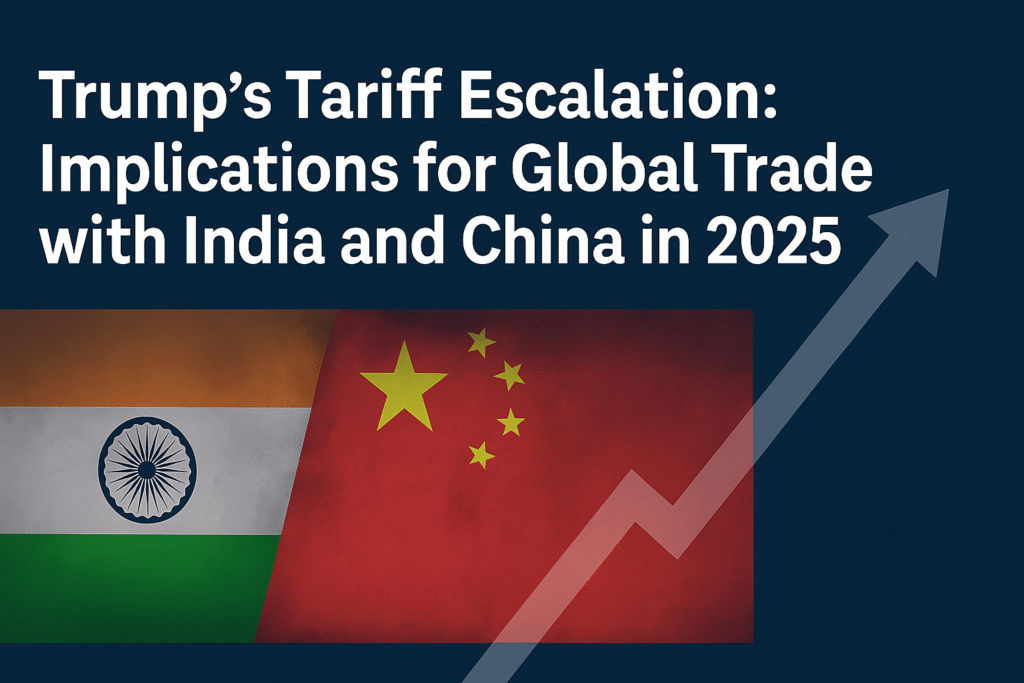In 2025, the global trade landscape has been dramatically reshaped by President Donald Trump’s aggressive tariff policies under his second term in the White House. The renewed and escalated tariffs on imports from India, China, and other countries mark one of the highest tariff rates seen in over a century, profoundly impacting bilateral trade relations and global commerce dynamics.
The Surge in US Tariffs: Key Facts
Since early 2025, the average US tariff rate has soared from under 2.5% to nearly 27%, with specific tariffs on Indian and Chinese goods climbing even higher. Notably, an additional 25% tariff was imposed on Indian exports beginning August 7, 2025, targeting shipments linked to India’s continued import of Russian crude oil, effectively doubling the total tariff rate on many Indian products to 50%. Similarly, Chinese goods have been subjected to tariffs reaching up to 145% in some categories as retaliation intensified the ongoing US-China trade war.
This sweeping tariff regime includes steel, aluminum, automobiles, pharmaceuticals, semiconductors, and a wide array of consumer goods. Trump’s administration justifies these measures as necessary to protect US manufacturing, address large trade deficits, and exert economic pressure related to geopolitical issues such as Russia’s war in Ukraine.
Trump tariffs on china and india 2025: Trade Disruption and Rivalry
India faces some of the harshest trade repercussions, with tariffs hitting sectors like apparel, precious stones, jewelry, footwear, and furniture, severely disrupting export businesses—especially small exporters dependent on the US market. For instance, India’s carpet industry, which annually generates billions in revenue and employs millions, has nearly halted shipments to the US following the tariff hike. Indian exporters cite increased uncertainty and loss of competitiveness versus rivals such as Vietnam, Bangladesh, and China benefiting from lower tariffs.
China remains a significant target, with tariff rates skyrocketing and retaliatory duties escalating the trade war. However, political considerations have delayed some of the steepest additional tariffs on China temporarily, reflecting a complex strategic calculus amid persistent tensions.
Broader Global Trade Implications
Trump’s tariff escalation has ripple effects beyond India and China. The imposition of high tariffs disrupts global supply chains, increases production costs, and threatens to slow global trade growth. These policies contribute to higher prices for consumers and producers in the US and abroad, and have already led to market volatility, including the 2025 US stock market crash that followed the announcement of sweeping reciprocal tariffs.
The move has also strained diplomatic and trade relations with key partners, threatening decades of progress toward trade liberalization. While some countries push back through retaliatory tariffs, others like the European Union weigh calls to impose their own tariffs to pressure Russia via economic sanctions.
Strategic Outlook for Indian and Chinese Exporters
In response to the new tariff realities, exporters and sourcing agents in India and China must adapt quickly. Businesses face urgent needs to diversify markets, optimize supply chains, and engage in strategic negotiations to mitigate tariff impacts. Indian exporters must especially navigate heightened costs and competitive disadvantages, as favored trading partners of the US enjoy comparatively lower duties.
For sourcing companies like Panoramic Sourcing that facilitate trade in industrial and handcrafted products, staying informed about tariff changes and trade policies is critical. Advising clients on tariff compliance, alternate sourcing options, and market diversification can provide a competitive edge amid ongoing geopolitical trade uncertainties.
Conclusion
Trump’s 2025 tariff escalations have introduced new challenges for global trade, especially for India and China, with widespread implications on trade flows, business competitiveness, and diplomatic ties. Companies engaged in international sourcing and export-import businesses must remain vigilant and proactive to navigate this evolving trade environment effectively.
FAQ
Q1: What are the key tariff changes introduced by Trump in 2025 affecting India and China?
A1: President Trump increased US tariff rates sharply in 2025, with average tariffs rising to nearly 27%. Indian goods now face tariffs up to 50%, including a 25% increase related to India’s continued Russian oil imports. Chinese goods face tariffs ranging up to 145% in some categories amid ongoing trade tensions.
Q2: Why has the US imposed higher tariffs on India and China?
A2: The US administration justifies the tariffs to protect domestic manufacturing, reduce trade deficits, and exert geopolitical pressure, particularly concerning Russia’s war in Ukraine. India and China’s purchases of Russian oil are a key factor triggering increased levies.
Q3: Which Indian export sectors are most affected by these tariffs?
A3: Sectors severely hit include textiles and apparel, gems and jewelry, carpets, seafood (e.g., shrimp), organic chemicals, machinery, auto parts, and furniture. Some major exports like pharmaceuticals and electronics remain exempt.
Q4: How are these tariffs affecting Indian exporters?
A4: Indian exporters face increased costs, loss of competitiveness, and disrupted trade flows to the US. The carpet industry, among others, has nearly halted shipments. There is growing uncertainty and pressure to diversify exports.
Q5: What is the impact on China in this tariff escalation?
A5: China is heavily targeted with very high tariffs, intensifying the US-China trade war. However, some additional steep tariffs on China are temporarily delayed due to strategic political considerations.
Q6: How do these tariffs impact global trade beyond India and China?
A6: The tariff escalation disrupts global supply chains, raises costs for manufacturers and consumers, slows trade growth, and has caused market volatility including a US stock market crash post-announcement.
Q7: What should exporters and sourcing agents in India and China do to navigate these challenges?
A7: Businesses must diversify markets, optimize supply chains, and engage in strategic trade negotiations. Staying updated on tariff changes and advising clients on compliance and alternate sourcing can mitigate risks.
Q8: What is the outlook for US-EU cooperation on tariffs against India and China?
A8: Trump has urged the EU to impose up to 100% tariffs on India and China as a pressure tactic on Russia, but EU officials remain cautious and are unlikely to escalate tariffs to that extent soon.

